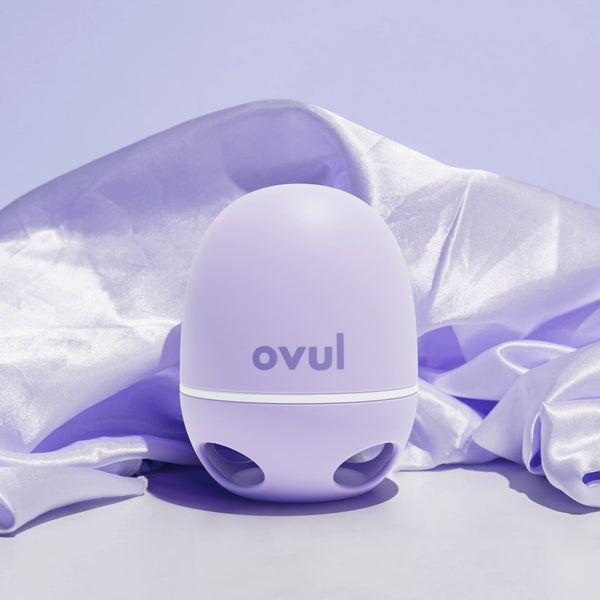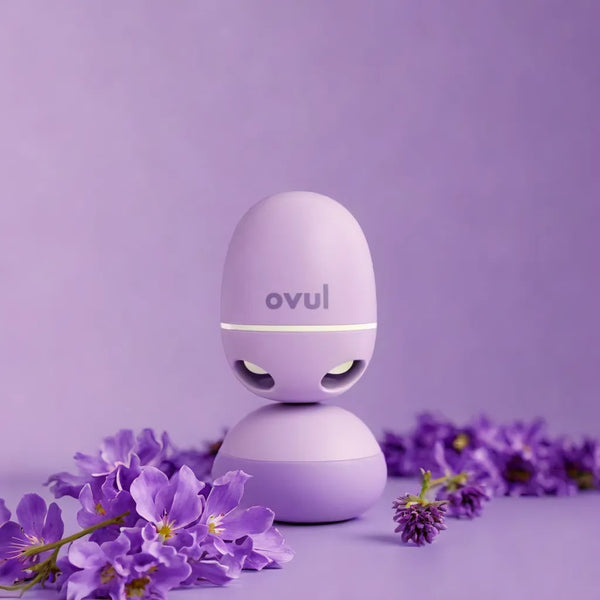
Estrogen & Estradiol Test at Home | Female Hormone Kit for Women’s Health
Test Details
How is an estradiol test done? For example, you can do an at home estradiol test or estrogen test kit. They allow you to take a sample at home - this can be saliva (estrogen saliva test).
When you receive the results of the estradiol test, you will see numbers that show your estradiol level. The doctor can explain what these values mean for you. It should be taken into account that the estradiol test normal range may differ slightly, but there are general norms.
As for the cost, the estradiol test cost can vary. Home kits are sometimes cheaper than tests in a clinic, but this depends on many factors.
What is an estradiol test?


Step 1
Split
Open the device and wait for the indicator light to flash once. It's ready to use.
Step 2
Drop
Use your finger to deposit a drop of saliva into your Ovul.
Step 3
Check
Close the device to start the analysis. Get your results in the Ovul App.
Why do I need an estradiol test?
General Overview
What are estrogens?
Estrogens are hormones that are primarily produced in the ovaries. Small amounts of estrogen are also produced by the adrenal glands and fatty tissue. During pregnancy, this hormone is also synthesized by the placenta. Estrogens affect many parts of the body, including the bones, heart, blood vessels, skin, brain, and even mood. That's why it's so important to check estrogen levels to maintain good health.
What types of estrogens are there?
There are three main, natural forms of estrogen, each of which has its own unique role and predominates during certain periods of a woman's life:
- Estradiol (E2). This hormone is the strongest and most common estrogen in women of reproductive age. It is important for the menstrual cycle, ovulation, and maintaining pregnancy. When doctors perform an estradiol test, they usually measure its level. The amount of this hormone fluctuates constantly throughout the cycle, reaching its peak just before ovulation.
- Estrone (E1). Estrone is the primary estrogen in women after menopause. It is produced from other hormones in fatty tissue and the adrenal glands. Although estrone is less active than estradiol, it is still very important for bone health and other tissues after menopause.
- Estriol (E3). This type of estrogen is produced in large amounts by the placenta during pregnancy. Its levels increase significantly as the fetus develops and is used as an important marker of fetal health. Outside of pregnancy, estriol levels are very low.
It is important to note that the balance between these types of estrogen in the body can change under the influence of various factors, including age, health status, and medications taken.
What is the role of estrogens in women?
Estrogens are very important for women, affecting almost all body systems. They perform many vital functions:
- Reproductive system. Estrogens play a key role in puberty, responsible for the appearance of secondary sexual characteristics. They also regulate the menstrual cycle, helping the endometrium to grow and eggs to mature in the ovaries.
- Bone health. Estrogens play a critical role in maintaining bone density. They help prevent bone loss, which is especially important after menopause, when estrogen levels drop, increasing the risk of osteoporosis.
- Cardiovascular system. These hormones help blood vessels stay flexible. They also affect cholesterol levels and protect against atherosclerosis, reducing the risk of cardiovascular disease.
- Skin and hair. Estrogens play a key role in maintaining the elasticity and moisture of your skin, as they influence the production of collagen and elastin. These hormones also help keep your hair healthy: they reduce hair loss and make it shinier.
- Brain and mood. Estrogen (female hormone) levels affect the brain, which impacts cognitive function (thinking), memory, and mood. When estrogen levels fluctuate, it can cause mood swings, increased irritability, and even lead to depression.
Given this wide-ranging impact, even regular estrogen test at home can provide valuable information about your health.
It is important to know what should my estradiol level be.
Estrogen levels in women fluctuate constantly, both throughout their lives and during their menstrual cycle. That is why an estradiol levels chart is a very useful tool. Normal estradiol values may vary slightly depending on the laboratory performing the test, but there are general guidelines that are measured in picograms per milliliter (pg/ml).
Normal Estrogen Levels by Age (Women)
The estradiol levels chart by age shows that estradiol levels vary greatly depending on age:
- Before puberty (girls under 8-10 years old), levels are very low, usually less than 10-20 pg/mL.
- During puberty, levels begin to rise gradually, reaching values between 15 and 85 pg/mL as secondary sexual characteristics develop and the first menstruation approaches.
- During reproductive age (menstruating women), levels are significantly higher and fluctuate depending on the phase of the cycle. The total range can be from 30 to 400 pg/ml, but specific values depend on the phase of the cycle.
- During pregnancy, levels rise sharply, starting at approximately 180-2500 pg/mL in the first trimester and reaching 3500-60000 pg/mL and above by the third trimester.
- During perimenopause, levels become highly variable, with both high spikes and low drops. The range can be very wide, for example, from 10 to 350+ pg/ml on different days.
- After menopause, levels become very low again, usually less than 10-30 pg/ml, often even in single digits. This is due to the cessation of ovarian function.
Estrogen Levels by Menstrual Cycle Phase
Here are how estradiol levels throughout cycle change in women of reproductive age.
At the beginning of the menstrual cycle, during the so-called follicular phase (which coincides with menstruation), estradiol levels during period are relatively low. As a rule, this indicator ranges from 20 to 80 pg/ml.
Middle of the cycle (before ovulation / preovulatory peak). Estradiol levels ovulation rise sharply, reaching their peak, which can range from 150 to 400 pg/ml, sometimes even up to 500 pg/ml. This peak of estradiol levels at ovulation signals to the brain that the egg is ready to be released.
After ovulation (luteal phase).
During the luteal phase, estradiol levels usually range from 60 to 200 pg/ml. If fertilization does not occur, the amount of estradiol decreases by the end of this phase, and menstruation begins.
Understanding these changes helps your doctor correctly interpret estradiol test results and check estrogen levels, as well as determine whether your estradiol levels women are normal for your cycle phase and age.
High estrogen levels in women
Excessively high estrogen levels can cause various problems:
- irregular or heavy periods;
- breast tenderness or pain;
- weight gain, especially in the hips and abdomen;
- mood swings, irritability;
- headaches;
- sleep problems.
There may also be an increased risk of certain diseases, such as uterine fibroids, endometriosis, or even some types of cancer (e.g., breast cancer).
Low estrogen levels in women
Low estrogen levels can also cause unpleasant symptoms:
- irregular periods or no periods;
- hot flashes and night sweats (common during menopause);
- vaginal dryness, which can cause discomfort during sexual intercourse;
- mood swings, depression;
- sleep problems;
- decreased libido;
- fatigue;
- thinning hair;
- loss of bone density (osteoporosis).
Your doctor may order an ultra sensitive estradiol test to more accurately measure very low levels.
Estrogen during pregnancy
During pregnancy, estrogen levels, especially estriol and estradiol, increase significantly. This is completely natural and important! These hormones play a key role in your baby's development and help maintain a healthy pregnancy. Estradiol levels early pregnancy begin to rise and continue to increase as the baby grows, preparing your body for the upcoming birth.
What happens to estrogen during menopause?
Menopause is the period in a woman's life when the ovaries stop producing eggs and, accordingly, significantly reduce estrogen production. This is a natural process that usually occurs between the ages of 45 and 55.
Around this time, estradiol levels drop sharply, causing many unpleasant symptoms of menopause. You may experience hot flashes, night sweats, vaginal dryness, mood swings, and even bone density loss. To find out for sure, you can take an estrogen test at home.
Sometimes women are prescribed hormone replacement therapy (HRT) to relieve menopause symptoms, but this decision should only be made with a doctor.
An estradiol test is a useful way to check your hormone levels. If you have questions about your health or any symptoms, it is always better to go to the doctor and consult. He will prescribe you the necessary tests, and the estradiol test price is available with us. Your doctor will help you understand your estradiol levels and decide what to do next. Timely diagnosis is important for maintaining hormonal balance and overall well-being. Based on the test results and your medical history, the doctor will be able to determine the best treatment plan or correction, if necessary. Do not delay a visit to a specialist, self-care is a priority.




